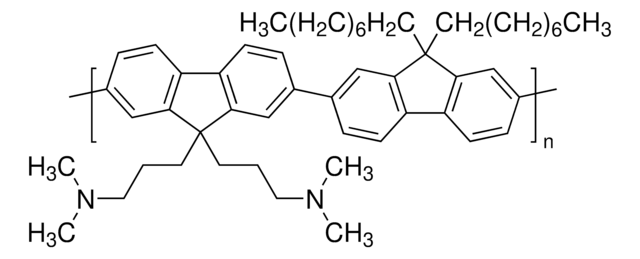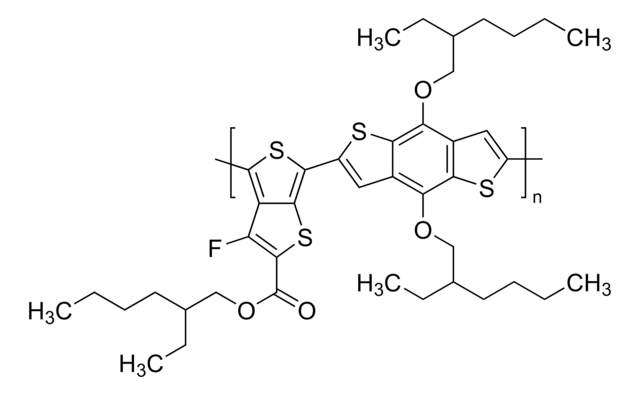906980
PFN-Br
Sinónimos:
OS0995, PFN-P2, Poly(9,9-bis(3’-(N,N-dimethyl)-N-ethylammoinium-propyl-2,7-fluorene)-alt-2,7-(9,9-dioctylfluorene))dibromide
About This Item
Productos recomendados
form
solid
mol wt
Mw 30,000-50,000 by GPC
greener alternative product characteristics
Design for Energy Efficiency
Learn more about the Principles of Green Chemistry.
sustainability
Greener Alternative Product
color
beige to yellow
mp
>200 °C
solubility
DMF: soluble
DMSO: soluble
alcohol: soluble
chloroform: insoluble
water: soluble
PDI
2‑3.2
greener alternative category
, Enabling
¿Está buscando productos similares? Visita Guía de comparación de productos
Categorías relacionadas
General description
Application
OPV devices with PFN-Br interfacial layer showed overall enhanced short-circuit current density, open-circuit voltage, fill factor and corresponding high efficiency in the inverted OPVs. This was attributed to the good contact between ZnO electron extraction layer and the active layer, good interface adhesion between the electron extraction layer and active layer, and enhanced charge transport via suppressed bimolecular recombination.
Recent report of OPV with a record energy conversion efficiency of 17.3% also utilized PFN-Br, spin-coated on top of ZnO to improve the interfacial properties.
Tandem Cell Device performance:
ITO/ZnO/PFN-Br/PBDB-T:F-M/M-PEDOT/ZnO/PTB7- Th:O6T-4F:PC71BM/MoO3/Ag
Voc=1.642 V
Jsc=14.35 mA/cm2
FF=73.7%
PCE=17.3%
PFN-Br finds application in a wide range of areas:
- OPV interficial layer (metalic oxide compact layer)
- OLED electron transport layer
- Perovskite solar cells
- Flexible printed electronics
- Cationic polymer electrolyte
- Anion exchange material
- Light emitting electrochemical cells
Other Notes
Storage Class
11 - Combustible Solids
wgk_germany
WGK 3
flash_point_f
Not applicable
flash_point_c
Not applicable
Certificados de análisis (COA)
Busque Certificados de análisis (COA) introduciendo el número de lote del producto. Los números de lote se encuentran en la etiqueta del producto después de las palabras «Lot» o «Batch»
¿Ya tiene este producto?
Encuentre la documentación para los productos que ha comprado recientemente en la Biblioteca de documentos.
Los clientes también vieron
Artículos
Explore the eco-friendly potential of organic thin film transistors (OTFTs) for detecting chemical analytes, identifying viruses, and assisting in health diagnostics. This mini-review highlights challenges of achieving sustainability, safety, and biodegradability of each component of an OTFT sensor.
Professor Chen (Nankai University, China) and his team explain the strategies behind their recent record-breaking organic solar cells, reaching a power conversion efficiency of 17.3%.
Nuestro equipo de científicos tiene experiencia en todas las áreas de investigación: Ciencias de la vida, Ciencia de los materiales, Síntesis química, Cromatografía, Analítica y muchas otras.
Póngase en contacto con el Servicio técnico


![Poly[(9,9-di-n-octylfluorenyl-2,7-diyl)-alt-(benzo[2,1,3]thiadiazol-4,8-diyl)] average Mn ≤25000](/deepweb/assets/sigmaaldrich/product/structures/428/661/1c4ebb98-9d51-48c0-96c7-e556ca425aa4/640/1c4ebb98-9d51-48c0-96c7-e556ca425aa4.png)

![[6,6]-Phenyl C61 butyric acid methyl ester >99.5%](/deepweb/assets/sigmaaldrich/product/structures/359/221/d990c746-0960-4c69-bf76-fe09b193824d/640/d990c746-0960-4c69-bf76-fe09b193824d.png)








